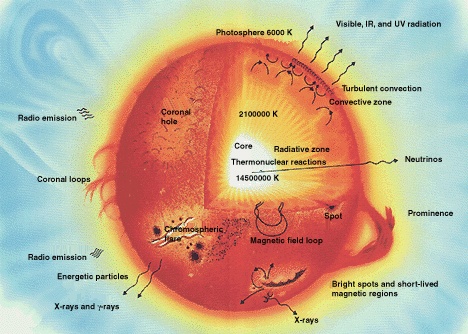Some Facts About Sun
Hello friends, how u identify that it is morning or evening?
The answer is by the ‘Sun’.
Every planet of the solar system is moving around this big Star. In this article I am going to share some information about the Sun:
The sun is a star, just like the other stars we see at night. The difference is distance -- the other stars we see are light years away, while our sun is only about 8 light minutes away (many thousands of times closer).
Officially, the sun is classified as a G2 type star based on its temperature and the wavelengths or spectrum of light that it emits. The sun is an "average" star, merely one of billions of stars that orbit the center of our galaxy.
The sun has "burned" for more than 4.5 billion years and will continue to do so for several billion more. It is a massive collection of gas, mostly hydrogen and helium. Because it is so massive, it has immense gravity, enough gravitational force to hold all of hydrogen and helium together (and to hold all of the planets in their orbits around the sun!).
The sun does not "burn" like wood burns. Instead the sun is a gigantic nuclear reactor, as you will learn on the following pages...
Parts of the Sun
The sun is made of gas and has no solid surface as Earth does. However, it still has a defined structure. The three major surface areas of the sun are shown in the upper half of
· Core
· Radiative Zone
· Convective Zone

Sun Facts
· Average distance from Earth = 93 million miles (~150 million km)
· Radius = 418,000 miles (696,000 km)
· Mass = 1.99 x 1030 kg (330,000 Earth masses)
· Makeup (by mass) = 74 percent hydrogen, 25 percent helium, 1 percent other elements
· Average temperature = 5,800 degrees Kelvin (surface), 15.5 million degrees Kelvin (core)
· Average density = 1.41 grams per cm3
· Rotational period = 25 days (center) to 35 days (poles)
· Magnitude = -26.8 (apparent), +4.8 (absolute) Apparent magnitude refers to a star's brightness in the sky from our vantage point on Earth. Absolute magnitude is the star's true brightness if all of the stars were the same distance from Earth. The lower the number, the brighter the star.
· Distance from center of Milky Way = 25,000 light-years
· Orbital speed and period = 138 miles per second (230 kilometers per second) and 200 million years

|
|
